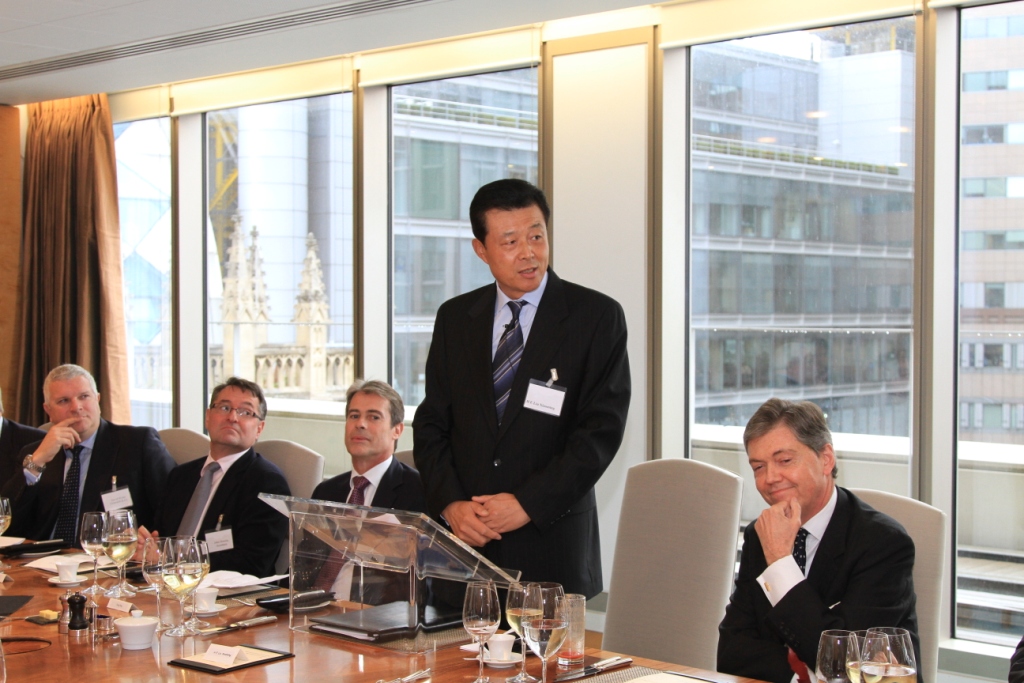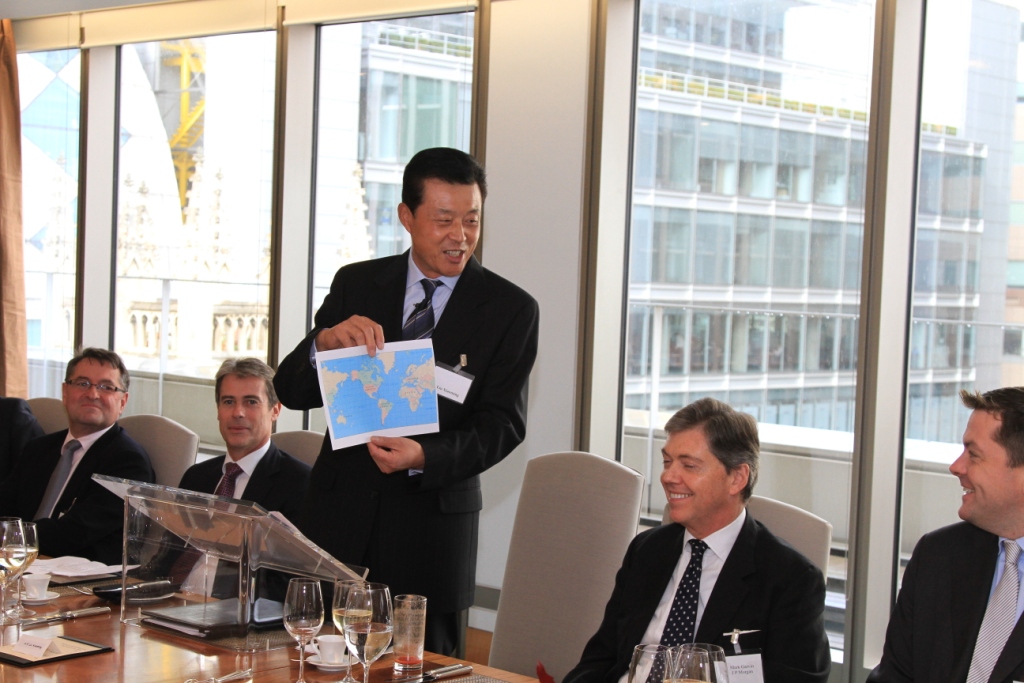|

Mr. Mark Garvin,
Mr. David Shellard,
Ladies and Gentlemen,
It’s with great pleasure that I join you at this luncheon of the American European Business Association.
I have been invited to discuss China’s development and its relations with America and Europe.
Through the past 30 years, the American European Business Association has built a strong reputation. It has progressed transatlantic understanding and cooperation and advanced opportunities in a globalised world.
That globalised world means that it is very appropriate to include China in any dialogue about Europe and America. So I am delighted you have hosted this discussion on the shared future of China, America and Europe.
I guess two issues are very much at the front of your minds. First the future of the Eurozone. Second is the political debate in the US over economic decisions. Both these matters are having a profound impact on the world.
The media is brimming over with discussions on these issues, so today for a change I want to take you to a different view of the world.
Let me start off with this question. Geographically, what lies between North America and Europe?
The answer appears so simple – the Atlantic Ocean. You might say it is such an easy answer that it's a no-brainer question.
But the instant answer means you are thinking of the world in only one dimension.
The world is round and so there is another correct answer to the question of what lies between America and Europe. That answer is the Pacific Ocean and Asia.
That second correct answer is a vivid reminder of two important things.
First, people tend to perceive the world looking back into the past. Or, in other words, there’s an inertia out there resisting new ways of thinking.
However, such inertia quite often leads to misjudgment and bias.
Sadly, this is the way the western countries have been looking at China for decades. This deeply entrenched paradigm creates a fog of thinking that blinds seeing the real China.
In economics, there’re those in western countries who argue that China’s is unable to go beyond the ‘boom-and-bust cycles’ and the ‘middle-income trap’.
Other commentators say that they doubt China’s economic sustainability after over 30 years of high growth. They point to selective evidence such as higher labour cost, property bubbles, lending squeeze and local government debt risks. Many make the case that the Chinese economy will have a hard landing.
However, if you choose to do a deep analysis, and from within China, you will come to a different conclusion.
Obviously, there are short term challenges in the Chinese economy. But it is clear that China’s economic fundamentals are strong and its long-term growth trend is positive.
There has been a lot of focus in past months on two facts. First China is the world’s biggest exporter. Second China ranks as the second largest economy. I believe that it is very important to view these strengths in the context of the comparative weakness of China.
It is really important to grasp these facts:
· China is far from a developed country.
· China’s per capita income is way lower than the developed world.
· China faces a wide urban-rural divide and sharp regional disparities.
· China is moving faster to restructure its economy and recast its growth model.
· The heart of this strategy is to reorient from export and public investment to greater consumption and technology innovation.
All this means that China’s slowdown right now is temporary. The growth potential of China over the next twenty years is enormous.
We have reason to believe that China’s development is sustainable and its growth quality will be even higher.
Let me now turn to politics and China.
When it comes to China’s political reform I always find media coverage in America and Europe is negative and gloomy.
A sense of ‘disappointment’ seems to be the prevailing mood. This stems from continuous comment suggesting China should adopt the political systems in western countries.
I believe that if the foreign media coverage of politics in China were more inclusive and objective, then the conclusions can be vastly different.
An analysis of China in greater depth will show that China has come a long way in promoting democracy:
· The Chinese Government has increasingly put public interests above other considerations.
· The People’s Congress system has been continuously strengthening.
· Deputies elected to Congresses are playing ever more effective supervisory roles.
· The grass-roots democratic organisations are vibrant.
· Chinese people have a clearer sense of ownership of society.
· The voices of Chinese people in public affairs are louder through internet, microblog and other public channels.
Turning to foreign policy.
The developed countries’ logic tends to be ‘power leads to hegemony’. In some foreign media China has recently been labeled as ‘being assertive’.
These media point to China playing tough on the South China Sea issue. This is interpreted as a sign of China’s new diplomatic posture.
However, two basic facts are often ignored.
First, those South China Sea islands have been part of the Chinese territory reaching deep into our history.
China’s sovereign claims are supported by sufficient evidence in the international law, and such claims were explicitly recognized by other countries.
Second, China supports the principles of ‘shelving disputes and carrying out joint development’ by relevant claimants as the best way toward a solution.
In contrast, some countries are strengthening the grip over their ‘illegitimate gains’ and bringing in countries from the outside as development partners.
These counterproductive actions further complicate the situation and violate China’s sovereignty, territory and maritime interests. In such a context, China’s repeat of its established position is a natural and necessary response.
Against this background there is still a clear will from China to talk and negotiate.
China wishes to deal with problems in a way that is constructive.
Right now, all sides must be cool-headed and show restraint. No action should be allowed to complicate and expand the disputes. The pressing priority is to keep the South China Sea peaceful and stable.
China’s stance on the South China Sea is a clear example of our broader approach to the international relations.
The characterisitics of China as a nation are:
· peaceful;
· rational and conscious of the larger picture;
· China knows the days of power politics and hegemony are over
· and win-win cooperation is the only choice in our time.
Another topic associated with the South China Sea is China’s aircraft carrier.
There seem to be immense concerns about it as a symbol of China’s military expansion.
The reality is China has an 18,000-kilometre coastline.
China has 3 million square kilometers of waters under its jurisdiction according to the UN Convention on the Law of the Sea.
So it is obvious that our aircraft carrier is important to protect our sovereignty and maritime interests.
According to The Guardian newspaper eight countries own aircraft carriers today.
These countries include developed countries such as America, France, Italy and Spain. But aircraft carriers are operated by developing countries like India, Brazil and Thailand.
So I don’t see why a Chinese aircraft carrier is billed as the ‘mark of hegemony’.
Britain has no aircraft carrier in service now, but is building a new generation of aircraft carrier called the Queen Elizabeth Class.
So, China’s unveiling of an aircraft carrier shouldn’t be regarded as a surprise move. It’s merely what China should do to strengthen defense capabilities as a large, responsible country.
You can be certain that China is not intending to be locked into an arms race. Still less does China pursue any sort of hegemony over the sea.

So, the first thought I want to leave you with is the need to have a broader picture and develop a balanced view about China.
As I said this means having a fresh perspective of the world.
I now return to my earlier reference to the transatlantic geography.
I will draw your attention to a second point.
If you look at world s published in China they look very different from those in Europe and the USA.
What you find is that Chinese maps put China at the centre. On the either side of the map you find America and Europe.
Chinese maps roughly divide the globe into three major parts, which are evenly spaced apart.
These three major parts have great symbolism in current global trade patterns. It is a most important fact that in economics and trade, the ties among China, America and Europe are closer than ever. We are each other’s major trade and investment partners.
To be specific:
· China is the EU’s second largest export destination and the largest source of imports.
· The EU is China’s largest export market and the second largest source of imports.
Meanwhile:
· China is America’s third largest export destination and number one source of imports.
· And America is China’s number two export market and the fifth largest source of imports.
In addition, China’s commercial ties with Europe and America are widening:
· from trade in goods to services;
· investments;
· merger and acquisition;
· technology transfer;
· rerch and development;
· to cooperation and marketing.
The best examples of the deepening of our economic partnership include:
· The EU and America are China’s number one and number three investors today.
· This year, China published its “12th Five-Year Plan”, announcing to boost internal demand and consumption and projecting an import of over eight trillion dollars worth of goods over the next five years.
· This plan followed America’s National Export Initiative and the EU’s 2020 Strategy.
· And all this means more opportunities for Chinese companies and their European and American peers to cooperate to create mutual economic benefits.
This is what our globalised era is all about.
Economies are more interdependent and their interests and destinies are inseparable.
In good times, all economies grow and gain from cooperation and prosperity. In tough times, no one is immune from the crisis. As one western saying goes, ‘We are all together in the same boat’.
In China we have a similar proverb: ‘cross the river together in the same boat’.
It not only shows the fact of ‘all being in the same boat’, but also stresses the need to ‘cross the river together’.
As you are fully aware the world is in its third year of financial crisis. I feel sure you will agree that solutions will only come through collaborations. So, we badly need this spirit of ‘crossing the river together’ to overcome the crisis.
To ‘cross the river together’, we must build up confidence and strengthen cooperation to battle the crisis and promote a sustained recovery.
But the mutual help of the international community can only be effective when it’s based on self-help of individual countries.
The number one priority for governments around the world is to take real responsibility to put their own house in order. This is the essential first step for any rescue plan to take hold.
As we combat the crisis together, we must make sure the homegrown crisis is not shifted to others. And ‘beggar-thy-neighbour’ politics should have no place in our strategy.
What we need is openness and cooperation, instead of protectionism and restrictions.
It is vital for all countries that we all commit to free trade and globalisation.
What is very clear is that protectionism and anti-globalisation are false choices that will only suck the world deeper into the crisis.
China has taken decisive actions on many fronts to support globalization and so help pull the world economy back from the current financial crisis:
· China has shown strong confidence in Europe and Euro.
· China has pledged not to reduce its holdings of euro bonds.
· We support the counter-crisis measures by the EU and the IMF.
· And China has not only put together a strong package to stimulate demand at home, but also sent out over 30 large purchase missions abroad, mainly to America and Europe, to increase imports.
In addition, China is encouraging its businesses to ramp up outward investment.
Figures show that China’s outbound investment keeps growing by over 40 percent each year. It had reached 68.8 billion dollars by 2010, making China the world’s fifth largest investor. This is a strong boost to job creation and economic growth in host countries.
And since June last year, when China announced further reforms to its exchange rate regime, our currency, the Renminbi, has strengthened by 7 percent against the US dollar.
The reason behind such moves is self-evident.
China is deeply aware that a prosperous world needs China’s contribution and China’s own development is inseparable with the world.
In closing, I return to the question of geography at the outset.
Our world is indeed getting smaller. Our globe is closer to becoming a global village than ever in human history.
I say this to skeptics who say the world is too small to provide enough space for China, America and Europe to grow together. My view is that history will prove the opposite to be true.
And here’s what I believe in and what I think will happen.
A world in which China, America and Europe all prosper will be more stable, more prosperous and more harmonious.
Thank you!

|

